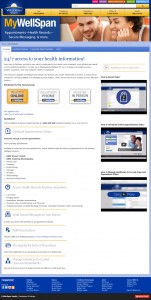WellSpan Health Uses LionShare’s CRM and Marketing Automation Platform to Crack the Code on Portal Sign-ups
// Ask the Expert, with Caty Wolf //
Caty Wolf is Manager of Marketing Communications at WellSpan Health, an integrated health system in central Pennsylvania. She is responsible for CRM and marketing automation, and works with LionShare’s business intelligence and CRM platform, DIATA®. WellSpan is using marketing automation to acquire and activate consumers on its patient portal.
// By Jane Weber Brubaker // eHST: Can you tell me about the marketing automation work you’re doing? It sounds like the first thing you’re doing is trying to get more portal sign-ups.
 CW: We are. Healthcare portals are huge. It’s not only required, it’s also just good business in terms of communicating with your patients. It gives them more options to be more involved in their care. And it can be a very important communication tool in terms of everything from compliance to clarifying physicians’ instructions. But it’s a new concept to our patients, this idea that you can go on your computer and actually send your physician a note at 2 o’clock in the morning, and they actually will respond to you the next day. Most people have trained themselves to wait until 8 a.m. when the office opens and call. We are finding that it’s a habit that’s very hard to break, not only for our patients but also for our staff in general.
CW: We are. Healthcare portals are huge. It’s not only required, it’s also just good business in terms of communicating with your patients. It gives them more options to be more involved in their care. And it can be a very important communication tool in terms of everything from compliance to clarifying physicians’ instructions. But it’s a new concept to our patients, this idea that you can go on your computer and actually send your physician a note at 2 o’clock in the morning, and they actually will respond to you the next day. Most people have trained themselves to wait until 8 a.m. when the office opens and call. We are finding that it’s a habit that’s very hard to break, not only for our patients but also for our staff in general.
eHST: So how are you cracking the code?
CW: On the patient side of things, the first challenge is to get them to sign up and start using the portal and seeing what a convenience it is. About a year ago we launched a monthly acquisition program, a very basic direct marketing-oriented campaign where once a month we would contact anyone on our file for which we had an email address if they were not already active with a portal account. Our winning subject line is “Important information about your medical records.” We’ve done really well with that. The campaign brought in approximately a quarter of all new accounts for our portal last year.
eHST: Is it an Epic portal?
CW: No, it’s actually a homegrown portal, MyWellSpan. It’s actually a pretty nifty tool. In fact, in some ways it’s a much more robust tool than some of the off-the-shelf packages.
eHST: How do people sign up?
CW: There are three different ways to sign up. You can do it in person, by phone, or online. When you sign up online, there’s online verification and authentication, and then you are active. If you sign up in person or by phone, it’s a two-step method. You receive an email with a specific code that you have to input to authenticate yourself.
eHST: How many email addresses did you send?
CW: I think we currently have about 130,000 emails records on file, total. Over the last year, for our MyWellSpan monthly acquisition campaign, we delivered approximately 608,000 emails to promote the program. From that, we created about 4,700 accounts. Our cost to create each of those accounts was $3.50.
eHST: Was that the only campaign you ran for portal sign-ups?
CW: We also had a drip campaign. It’s marketing automation basically. It’s triggered based on something. In our case, the something was that we had some applicants who were stuck in limbo. So you’ll remember that we had the folks who applied in person or over the phone, and they have the two-step process. We were targeting people who were stuck between step one and step two and hadn’t completed the sign-up process.
eHST: So is it kind of the equivalent of an abandoned shopping cart?
CW: Exactly. So for that we created a very simplified marketing automation campaign. The campaign was a series of three emails. It started at seven days after application, and then followed every two weeks after that, so week one, week three, week five. Each of the emails was just slightly more aggressive. By the third email, if you didn’t convert, we asked, “Are you having problems? Call us. Let us help you.”
eHST: What kind of results have you gotten from the drip campaign, or is it too early to tell?
CW: Well, glad you asked. What we found was that we mailed just under 14,000 people in limbo—between step one and two. Of those folks, we were able to get just under 5,000 to activate their accounts.
eHST: Wow!
CW: Yeah! So we were able to convert 36 percent of people who would’ve just probably stayed in limbo. I’ve been pretty amazed that such a simplistic approach has worked so well. It makes you wonder if we actually did something a little fancier what we could accomplish.
eHST: So what’s next on your agenda?
CW: The idea that we’re developing right now is to convert our monthly acquisition email campaign into a more automated drip campaign. The hope would be that within a few days of a new email address coming on board, we would be able to send someone an email with an offer to say: Please consider signing up for a MyWellSpan account, and here are all the benefits.
Our challenge right now is: Can we do it in a meaningful way that personalizes the message and improves our chances for conversion? So, for example, can we customize that initial message based on where the person had their encounter when they presented their new email address? Say you happen to be going for a lab test. As our very first message to you, could we say, “Did you know that you could see your lab results right now?” Or if you are a new primary care patient, we could be leading off with a message saying, “Please take this opportunity to review office notes from your most recent appointment.” So we think we have opportunities with some key groups to personalize that message. Right now, our data source doesn’t contain that level of detail, so we’re working hard to figure out how to get that included.
eHST: So as new people come onto the file, you would have a flag that would say what their initial activity was?
CW: Yes. So my vision is that we would probably have three or four customized opening messages based on the last touch that we had with that patient, and then we would also have a more generic stream for those folks whose category is just too small to create a custom message. If we can accomplish that more customized messaging, then the next step would be to develop a longer communication stream.
The thought would be: Let’s start to introduce them to all the different features of MyWellSpan. We’ve been developing how-to videos for things like: How do I schedule an online appointment? How do I sign up for proxy? How do I look at my lab results? How do I send a secure message to my provider? So that’s an opportunity to get people acquainted with MyWellSpan. Being able to take one feature at a time and delve into it and demonstrate it I think can be useful.
eHST: So you want people to do more than just sign up—you want them to use the portal.
CW: We have as a system some very aggressive utilization goals for the online appointment-scheduling feature, so that’s going to be a big focus of the drip campaign going forward, beyond purely acquisition.
Jane Weber Brubaker is Editor of eHealthcare Strategy & Trends.
Related Articles
Kindred Healthcare’s Marketing Automation Strategy Connects with Referral Sources and Consumers
Trinity Health and Christus Health Drive ROI with CRM
Marketing Automation Comes of Age: The Maturing of the Marketing Solutions Technology Industry
What Can Healthcare Marketers Do To Make Patient Portals More Compelling?


